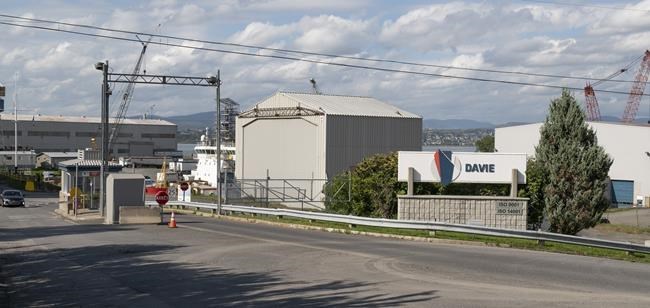Ottawa has quietly missed its own deadline for finalizing an agreement with a Quebec shipyard so it can start work on replacing the Canadian Coast Guard's aging icebreaker fleet.
The government said last summer that pending successful negotiations, it expected an agreement by the end of the year confirming Chantier Davie's addition to Canada's multibillion-dollar ship procurement program.
That have would paved the way for Davie to begin building seven new icebreakers that the Coast Guard desperately needs to replace its existing fleet, before mechanical problems start forcing ships into retirement.
Yet the Procurement Department, which is leading the negotiations, says talks with the shipyard located in Levis, Que., are still ongoing.
"Negotiations between the government of Canada and Chantier Davie are ongoing and specific details about the state of the negotiations cannot be provided at this time," department spokeswoman Stefanie Hamel said in an email.
"The qualification process is expected to be completed in 2023."
The missed milestone is the latest in a string of delays since Ottawa announced in December 2019 that Davie was the only shipyard to qualify for the icebreaker contracts, which are expected to be worth billions of dollars.
Government officials at the time said they expected a final deal to iron out the details by the end of 2020. They have since revised their target several times, in part to accommodate Davie so the company could provide documents to support its qualifying bid.
Davie spokesman Denis Boucher referred questions to the federal government, but said in an email: "There are no reasons to worry."
Yet every passing day raises the risk of one of the Coast Guard's decades-old icebreakers breaking down, hindering maritime traffic and trade in the St. Lawrence Seaway and Great Lakes, or research and resupply in Canada's North.
Conservative Sen. Leo Housakos asked Fisheries Minister Joyce Murray about those repeated delays earlier this month.
"Every year for the past three years, your government has promised to sign an agreement with Davie," he said in French.
"However, every year, it hasn’t kept its promise. Minister, why haven’t you been able to sign an agreement, and what is the impact of this failure on the 2030 delivery date?"
Officials say they are putting various measures into place to prevent any gap in the provision of federal icebreaking capabilities, including the purchase of three second-hand vessels through Davie.
Originally ordered in August 2018, the last of the three Norwegian-built icebreakers was only delivered by Davie late last year. By that point, the cost to Canadian taxpayers had soared from $610 million to nearly $1 billion.
The government has also spent hundreds of millions of dollars in recent years to extend the life of its fleet, most of which was supposed to have been retired by now.
That includes the 54-year-old CCGS Louis S. St-Laurent heavy icebreaker, which serves as the Coast Guard's flagship.
"The senator referred to the Arctic where it’s critical that Canada has the tools and capabilities to protect our waters, borders and ecosystems," Murray told Housakos. "And we’re making historic investments to do just that."
But despite such investments, the Coast Guard has lost several key vessels due to age while awaiting replacements. Among them was its most important ocean research vessel, the 59-year-old CCGS Hudson, which was retired last year.
Hudson's replacement is being built by Vancouver-based Seaspan Shipyards. Its cost has ballooned from an estimated $100 million to $1 billion, and won't be ready until at least 2025.
Boucher said it was too early to say what impact the ongoing talks would have on Davie's delivery of the seven icebreakers it will be expected to build, saying: "It would be speculative at this time to determine if it could be impacted."
During a parliamentary committee meeting last month, in which members of Parliament were told the talks were in their final stages, Coast Guard Commissioner Mario Pelletier said the aim is to start cutting steel in 2025.
"As we get closer to 2025, we'll be able to assess whether there's some slippage and come up with some interim measures, such as the ones we have in place right now," he said. "If we need to look at more interim measures, we will."
Davie's path to potentially joining the federal shipbuilding plan has been long and winding.
It was initially excluded from the shipbuilding plan following a 2011 competition that selected Irving Shipbuilding in Halifax to build the navy's new warships, and Seaspan to build two new naval support ships and the bulk of the coast guard's new fleet.
The Quebec shipyard was able to pick up piecemeal work, including the construction of two federal ferries and the provision of several second-hand ships for the navy and coast guard.
Davie made no secret of its desire for more and, with help from allies in Quebec City and the opposition benches in Ottawa, the company lobbied the federal Liberal government hard for official inclusion in the shipbuilding plan.
At the same time, Seaspan was struggling to meet its delivery schedules thanks to mismanagement by both the Vancouver yard and federal government. All the while, the coast guard's fleet was becoming increasingly decrepit.
It was in this context that the Liberal government announced in August 2019 that it was adding a third yard to the plan to build Canada's next icebreaker fleet, and formally called for shipyards to indicate their interest.
Ontario shipyard Heddle Shipyards wasted no time accusing the government of stacking the deck in Davie's favour. Yet the Canadian International Trade Tribunal was blocked from investigating Heddle's complaint after Ottawa invoked a special exemption.
In December 2019, the government announced Davie was the only shipyard to meet its requirements.
This report by The Canadian Press was first published March 16, 2023.
Lee Berthiaume, The Canadian Press



